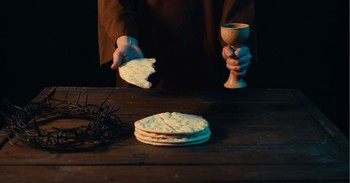“Swing Low, Sweet Chariot” is one of the best-known Christian hymns and African-American spirituals, written around the Civil War period. It’s a message of hope in a time of great hopelessness for slaves who looked to their heavenly home as their only chance at freedom. Some also used it as a coded message to move people through the Underground Railroad System. Because of its impact over the last 150 years, “Swing Low, Sweet Chariot” was included by the National Endowment for the Arts and the Recording Industry Association of America in its historic “Songs of the Century” lists.
What Are the Original Lyrics to Swing Low Sweet Chariot?
The full lyrics are as follows:
Refrain:
Swing low, sweet chariot,
Coming for to carry me home.
Swing low, sweet chariot,
Coming for to carry me home.
I looked over Jordan, and what did I see,
Coming for to carry me home?
A band of angels coming after me,
Coming for to carry me home. [Refrain]
If you get there before I do,
Coming for to carry me home;
Tell all my friends I’m coming too.
Coming for to carry me home. [Refrain]
The brightest day that ever I saw
Coming for to carry me home.
When Jesus washed my sins away,
Coming for to carry me home. [Refrain]
I’m sometimes up, I’m sometimes down,
Coming for to carry me home;
But still I know I’m heavenward bound.
Coming for to carry me home. [Refrain]
This version of the lyrics comes from the 1872 book Jubilee Songs as Sung by the Jubilee Singers of Fisk University.
The River Jordan, a band of angels, talk of being heavenward bound and a chariot to carry one home. All paint the picture of someone who knows their God, knows their Bible stories, and wants to be home with their heavenly Father. Considering the time of its writing and its tone, legend has it that the song was a “spiritual” likely written by one of two slaves owned around the Civil War period. But which one and why?
Who Wrote the Song and What Were the Circumstances?
This song has such an interesting yet controversial history. While the main players who established it in the canon of African-American music are the same, details split over who wrote the song. Some say former slave Wallace Willis wrote it. Others say enslaved woman Sarah Hanna Sheppard wrote it. But the song, regardless of authorship, ended up in the hands of those who later wrote it down and recorded it.
Story 1: Wallace Willis
According to the Hymnology Archive and American Songwriter, the story starts with the Trail of Tears. In 1830, Congress passed the Indian Removal Act to move Native Americans away from their eastern territories, sending them west of the Mississippi River. The Choctaw Nation was one of the first groups to take what became known as the Trail of Tears, leaving their homelands for Oklahoma.
It was not uncommon for Native Americans to own enslaved African-Americans at this time. Wallace was enslaved by Choctaw Nation member Britt Willis and moved with Willis to Oklahoma. Once there, Wallace and his wife, known to everyone as Aunt Minerva, worked for a Choctaw school for children called Spencer Academy. They lived in a cabin on the school grounds and sang various spirituals at night, including “Swing Low, Sweet Chariot,” which Wallace said he wrote. While working at the school, they became acquainted with Rev. Alexander Reid.
In 1871, Reid was in New York City. He heard a concert by the Jubilee Singers, an African-American a cappella ensemble made up of Fisk University students (most former slaves). Reid commented to the musical director that he had heard better music at the Academy. So he transcribed the music, wrote down the lyrics for “Swing Low, Sweet Chariot,” and sent them to the director. The Jubilee Singers added it to their repertoire. Sheet music was created for it in 1907, and the group first recorded it on vinyl in 1909.
Story 2: Sarah Hannah Sheppard
This version, included by Jubilee Singer John Wesley Work Jr. in his 1915 book about the history of African-American music, is more fantastic:
A woman named Sarah Hannah Sheppard was enslaved on a Tennessee plantation. Learning she was pregnant, she decided to drown herself so her child would never be enslaved. An older slave woman stopped Sheppard as she headed for the Cumberland River. The older woman said, “Don’t you do it, honey; wait, let the chariot of the Lord swing low, and let me take one of the Lord’s scrolls and read it to you.” Then, making a motion as reaching for a scroll and unrolling it, the older woman said, “God’s got a great work for this baby to do; she’s going to stand before kings and queens. Don’t you do it, honey.”
Sheppeard was convinced and wrote a song based on the experience. Later, she was sold and sent to Mississippi, while her daughter remained in Tennessee. The song spread by word of mouth, growing into its current version. According to Work, the daughter became a co-ed at Fisk University and joined the Jubilee Singers, sharing the song with her fellow singers. And as the older woman prophesied, the daughter stood before kings and queens when the group performed.
Does “Swing Low Sweet Chariot” Quote the Bible?
The hymn doesn’t directly quote any particular Bible verses, but references to people and things from the Bible appear throughout the song. The theme is leaving the struggles of this earth to go home to heaven—a theme often used in African-American slave spirituals. The singers had no freedom and were treated abominably. Their hope was for an eternity on the other side, where all pain and suffering will be gone.
The reference to the chariot is likely from Elijah being taken up to heaven in the whirlwind with chariots of fire in 2 Kings 2:11. The River Jordan alludes to the river that Joshua and the Israelites crossed with the ark of the covenant going before them into the Promised Land Joshua 3:13. Bands of angels are frequently reported in the Bible—at the birth of Jesus, in the book of Revelation and individual angels elsewhere. In Hebrews 1:14, angels are ministering spirits and may have been seen as those who would carry one to heaven.
Why did Spirituals Grow in the African-American Community During Years of Slavery?
The song is in the same vein as other “spirituals,” the term derived from the King James Bible translation of Ephesians 5:19: “Speaking to yourselves in psalms and hymns and spiritual songs, singing and making melody in your heart to the Lord.”
According to the Library of Congress, “Songs like ‘Sometimes I feel like a motherless child,’ and ‘Nobody knows de trouble I’ve seen,’ describe the slaves’ struggles and identification with the suffering of Jesus Christ. Other spirituals are more joyful. Known as ‘jubilees,’ or ‘camp meeting songs,’ they are fast, rhythmic and often syncopated. Examples include ‘Rocky my soul’ and ‘Fare Ye Well.’”
According to the Christianity.com article, “These Spirituals gave the slaves an identity which appearances seemed to belie: that of a people chosen by the Lord. Just as the Lord fought for Moses and the Israelites, just as he toppled Goliath before David, just as he appeared to Jacob on the ladder, so would he work in their lives. And if they were not delivered while living in this world, there remained freedom in the heavenly Canaan. Their songs summarized these beliefs.”
Perhaps their understanding of Jesus’ suffering on the cross resonated with them, having undergone immense suffering yet hoping for a place with no more tears.
Spirituals were not used simply to celebrate or lament; some were used to carry codes for people to escape slavery. Harriet Tubman used “Swing Low, Sweet Chariot” to tell people to get ready to escape to the north. She wrote several songs herself—the lyrics to her songs are available through the Harriet Tubman Historical Society. God designed music to be very powerful; in these cases, one song could save a life. Here is an early rendition of “Swing Low, Sweet Chariot” by the Jubilee Singers.
What Can “Swing Low Sweet Chariot” Teach Us about Our Final Hope?
The hymn’s author had such an assurance that they were heavenward bound they had the strength to endure tremendous hardships. It teaches us that through Jesus’ sacrifice on the cross, we can have that same assurance that we will be welcomed into heaven and the presence of our Heavenly Father when God calls us home. Only the Lord knows whether chariots and angels are part of that process. But it doesn’t change the fact that Jesus said, “And if I go and prepare a place for you, I will come back and take you to be with me, that you also may be where I am.” (John 14:3)
Photo Credit: © Getty Images/schankz
Mary Oelerich-Meyer is a Chicago-area freelance writer and copy editor who prayed for years for a way to write about and for the Lord. She spent 20 years writing for area healthcare organizations, interviewing doctors and clinical professionals and writing more than 1,500 articles in addition to marketing collateral materials. Important work, but not what she felt called to do. She is grateful for any opportunity to share the Lord in her writing and editing, believing that life is too short to write about anything else. Previously she served as Marketing Communications Director for a large healthcare system. She holds a B.A. in International Business and Marketing from Cornell College (the original Cornell!) When not researching or writing, she loves to spend time with her writer daughter, granddaughter, rescue doggie and husband (not always in that order).



